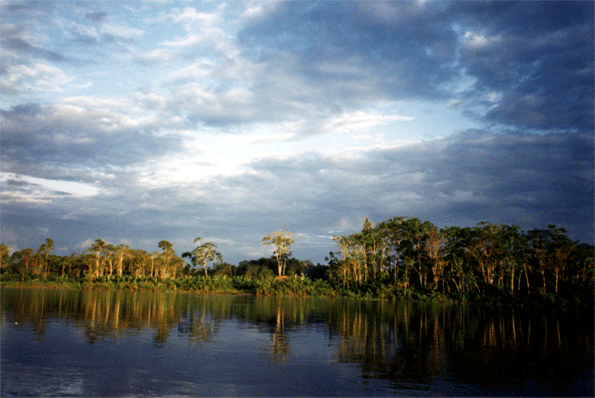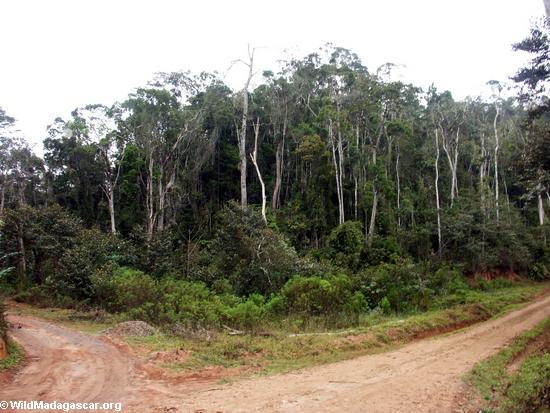Asphalt and Soya Dreams: Two Oceans, Two Countries and the Transoceanica
Chinese economy drives road-building and deforestation in the Amazon
Paving the Amazon rainforest to bring soybeans to China
Tina Butler, mongabay.com
April 17, 2005
The state of Madre de Dios in southeastern Peru is home to mountainous
cloud forests and low-lying rainforests containing the richest biodiversity
on Earth. It may also soon be home to a transcontinental highway. If all
goes according to plan and schedule, by June 2006, there will be an asphalt
road connecting Sao Paulo to Lima, and more importantly, the Pacific
Peruvian ports of Matarini, Ilo and San Juan. The east-west Carretera
Transoceanica — “transoceanic highway” — as the project is called, is viewed
as a long-awaited and close to finalized dream for proponents, namely the
Peruvian and Brazilian governments, agricultural groups and local residents,
and as a nightmare for environmentalists.
 Rainforest in the Peruvian Amazon |
The main reason for the road is the inefficient
trajectory raw materials and products currently must take in order to get to port. At
present, goods from Brazil must be transported to Atlantic ports to be
shipped or trucked across two countries, Argentina and Chile, to Chilean
ports on the Pacific. The Transoceanica would significantly reduce
transport times going out of Brazil and increase the supply as well as its
quality.
The big push to reach the Peruvian ports is the economic allure of
the Asian market. Brazil already sends 18 percent of its exports to Asia,
with this figure likely to increase at a rapid rate. China is literally
inhaling soybeans from Brazilian soya farms in the country’s central and
western areas, especially in the state of Mato Grosso. These former
rainforest regions are increasingly being converted into farmland, all to
supply the growing Asian demand, particularly with China’s exploding urban
population.
Brazil has big plans for expansion in order to keep supplying this
lucrative market. The agricultural minister, Roberto Rodrigues, has said
there is another 90 million hectares available for planting, a significant
increase over the current 62 million hectares being used for agriculture in
Mato Grosso. In addition to soya, cattle ranching is also a leading use of
land in the state.
Recently, Brazilian president,Luiz Inacio Lula da Silva led a delegation of
several government representatives and hundreds of business leaders to China
to encourage closer ties. After five days of talks on trade and diplomacy,
a growing alliance was in the works. Brazil will supply the goods China
requires and in return, China’s companies are positioning themselves to
provide capital to help Brazil achieve massive expansion in its crumbling
road, rail and port infrastructures. The Chinese interest is not limited to
Brazil however, and this is where Peru, the Transoceanica and the
controversy come in.
Those welcoming the highway argue for the sake of economics. Construction
of the road is expected to provide close to 20,000 jobs in Peru and once the
highway is operational, businesses and even more job opportunities should
open up in one of the country’s poorest and remote areas in the Andes and
the rainforest. Traffic from the Transoceanica should also encourage
investment in Peru’s inefficient and rundown ports, with a strong chance of
economic backing by China.
In Brazil, development is occurring much more quickly than in its neighbor,
but once Peru gets its pavement, this imbalance is likely to shift. Linking
to the Pacific is of such great importance to Brazil that the country has
offered to help Peru finance this section of the highway, putting up $420
million of the $892 million cost. This willingness to sponsor the road construction reflects the potential economic
gains to a country which has emerged as the key supplier of food to
China. Brazil’s economy has surged this year, with agricultural produce
accounting for more than 40 percent of exports. The goal of this road is to
strengthen and enhance the link to the Asian market, transporting exports of
beef, wood and wood pulp, soya and in the future, manufactured goods. Again
this appears to be an irresistible opportunity for all those on the side of
the road to advance economic opportunity for Peru.
On the paved Brazilian side of the Transoceanica, the impact of the road is
quite visible, even from the air. On either side of the thoroughfare,
forest is cleared anywhere from a few hundred yards to miles of farmland
extending away from the highway. Roadside towns are expanding, secondary
roads branch off from the highway; everywhere one looks, significant signs
of development, and deforestation, are apparent. And this is exactly what
opponents of the Transoceanica, namely environmentalists, are afraid of
happening on the Peruvian side.
For the environmentalists, the Brazilian side of the Transoceanica is a sad
precursor to what will happen in Peru, and not just any old land, but some
of the most environmentally precious and unique land on Earth. According to
many, while the road will bring profitable development to the area,
development will hurt Madre de Dios more than it helps. Roadways alter
patterns of human settlement, accelerate the destruction of natural habitat
and aid in the transmittal of disease. Alfredo Garcia, an anthropologist in
the state’s capital of Puerto Maldonado, believes the highway will bring
many problems to local indigenous peoples, including displacement and
acculturation. Further, black-market drug activity and prostitution will
likely increase among other ills.
 Roads in the rainforest typically result in significant deforestation from colonists and commercial developers. The Trans-Amazonian Highway was one of the most environmentally destructive projects ever in the Amazon basin. |
There are already dirt roads running through the Madre de Dios and
emigrants from the impoverished highlands come to work in the resource-rich
area. Road officials anticipate an approximate daily flow of 400 40-ton
trucks from Brazil. Many environmentalists fear that with the trucks will
come settlers, ready to clear forest and expand the farm belt.
Another activity that will undoubtedly increase is illegal logging, as
secondary roads are constructed and eager workers descend on the newly
accessible and mahogany-rich forest areas. The consistent depression in
world gold prices, a former top commodity export for Brazil, has resulted in
a newfound interest in the highly-valued hardwood. More than half the state
is federally protected through three national parks and a nature preserve
and an additional quarter of the land is owned by indigenous communities and
Brazil nut harvesters. There is not much legal mahogany to go around, so
woodcutters are trespassing on federal land, creating illegal
logging camps. And the few environmental enforcement officers have proven
to be easily corruptible and readily shirk their responsibilities with the
right amount of economic incentive.
The concerns of the environmentalists are valid. Peru is currently bearing
witness to its future simply by looking across the border to Brazil. And
further back in history, Brazil has seen its own repercussions from roads.
Several ill-advised World Bank-sponsored road and agricultural projects have
had environmentally devastating results. Destruction of the rainforest in
Brazil has accelerated since 1970, coinciding with the construction of the
Trans-Amazonian highway. 4,892,700 acres (2,016,400 hectares) are lost
annually and another 2,718,160 acres (1,100,000 hectares) are degraded by
logging beneath the canopy. Peru’s current deforestation rates are an
estimated 716,000 acres (290,000 hectares) per year. More importantly, Peru
has a smaller area of forest and some of the highest levels of biodiversity in the
world, so the threat is that much more immediate and profound.
Regardless of this very real environmental peril, the disputes between
various parties regarding the Transoceanica project persist as each side
holds fast to their beliefs. Brazil’s farming lobbies dismiss critics of
the highway, stating concerns and objections are “ill-advised” and only
“serving the interests of countries competing with Brazil in the export
markets.”
Other government bodies are more sympathetic, but do not see any other
viable mode of propelling development and economic stability. Puerto
Maldonado mill operator Alan Schipper Guerovitch claims opposition to the
road is short-sighted because it leaves the country in a position where there
is no way to develop, no possibility of growth. He told National Geographic
correspondent Ted Conover, “I ask you, what nation in the world can sustain
its people on only 20 percent of its resources? In a less developed country
you need to produce something the world really wants, and what the world
really wants now is mahogany.” Guerovitch’s statement, while specific to
his own problematic logging practices, is pertinent to the larger issue at
hand.
This attitude of development over preservation can be recognized at all
levels, all the way up to the president of Peru. President Toledo’s low
popularity ratings have increased the pressure to stimulate economic growth
and he has stressed the Transoceanica’s potential to bring jobs and trade to
an impoverished region. At the August 11, 2004 inauguration of the
construction of the Acre River bridge connecting the border towns of Assis,
Brazil and Inapari, Peru, Brazilian President da Silva spoke to an
enthusiastic audience, “We’ll generate more economic activity. We’ll
generate more wealth. We’ll generate more development.” This comment
prompted applause from local residents who care far more about jobs and their economic well-being than
protecting the rainforest. Judging their audience accurately, both
presidents barely mentioned environmental protection during the ceremony.
With the heady economic importance of the highway in mind, there are other
rifts between people regarding the Transoceanica. Back in 2003, two main
routes were being discussed, with a possible third option in mind and a
fierce competition broke out internally in Peru. The two states of Puno and
Cusco became rivals, wrangling for a piece of the highway and its economic
promise, resulting in clashes between residents, a brief takeover of local
governments and even a few road surveyor officials being taken hostage. It
seems everyone has a stake in the dream, regardless of the environmental
cost.
The Transoceanica is being viewed by many as South America’s infrastructure
project of the century. Whichever side an individual or group is on, there
is no denying the significant impact the highway will have on all the
nations involved. Brazil has the opportunity to grow even more, Peru simply
wants the same chance for Brazil’s economic success and China desires
access to South America’s growing agricultural basket. Will the environmental concerns be lost in the wake of the
excitement surrounding the final achievement of this long-awaited road?
Given China’s reportedly illegal and environmentally detrimental activity in
other parts of the world, opening Peru up to this market seems even more
inadvisable. But the promise of wealth is too seductive to resist.
Links: